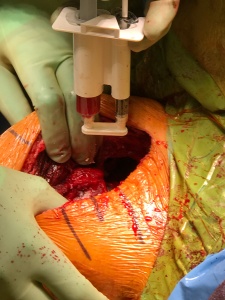Tom Wright, MD
Read complete study: The cost effectiveness of vancomycin for preventing infections after shoulder arthroplasty: a break-even analysis
Surgical site infection is one of the most common and expensive post-operative complications to manage in shoulder arthroplasty. The combination of increased methicillin resistance and decreased efficacy of IV cephlasporins, and Propionibacterium acnes infections , has led shoulder specialists to look for other methods to prophylax against infections in shoulder arthroplasty. Primary shoulder arthroplasty infection rates have been reported from 0-4%, and with revision arthroplasty, the rates are higher, occurring from 4-15% of the time. Although these rates are low, an infection in a shoulder arthroplasty has devastating effects on the patient and is extremely expensive. Surgical site infection accounts for 22% of all health care related infection costs estimated from $1-10 billion annually.
The authors in this article have been using vancomycin powder in the wound bed before closing the surgical site. The authors have looked at the reports from spine surgeries that have shown significant reduction in infection rates when comparing non-vancomycin treatment vs. vancomycin treatment. Based on this information, they have been using vancomycin powder in their shoulder operations since 2013. As with all things in our current health care system, any increase in cost must be justified, and this paper aims at looking at the cost effectiveness of treating patients preemptively with vancomycin powder in the local wound site. They looked at the average cost of 16 patients being treated for infection and quantified the stages of treatment and cost at each stage. The general standard of care for an infected shoulder arthroplasty for patients is as follows:
- Arthroscopic biopsy/aspiration
- Resection arthroplasty/ Antibiotic impregnated spacer
- PICC/Home care for 6 weeks
- Repeat biopsy
- Revision reverse shoulder arthroplasty
This treatment protocol for these 16 patients averaged $46,744.54 per patient. At the same facility a 1000mg bottle of vancomycin cost $17.15. Based on these data points, the analysis showed that the treatment with vancomycin powder needed to only reduce infection by .04% to be deemed cost effective (break-even).
My practice in a University setting tends to have a large referral base for revisions, which carries a higher infection rate. Because of this high-risk patient population (revision shoulder arthroplasty) and the significant resistance to cephlosporins, it caused me to review the spine literature.
I was impressed with the degree of reduction in spine infections that that has been reported with topical vancomycin in the spine wound bed. Kanj reported that patients without vancomycin powder treatment were four times as likely to have a deep infection as those who were treated with local vancomycin powder. Over the past five years I have been using a similar protocol and will place 1 gm of vancomycin in the wound in combination with PRP. We place vancomycin powder in the joint and under each layer of wound closure spread around with platelet rich plasma (PRP). Superficially we use vancomycin and platlet poor plasma followed by dermabond and no drains. It is our hypothesis that the PRP will distribute the vancomycin and potentially allow it to be resorbed more slowly. In addition, PRP helps with hemostasis, wound healing, decreasing edema and pain.

Over the last three years, we have expanded this technique to be used with revision infected shoulder arthroplasties. Since most shoulder arthroplasty infections occur with low virulent infections in good hosts, we now primarily perform primary exchange arthroplasties. When a shoulder arthroplasty infection is likely, we will remove all foreign bodies, implants, cement and suture, followed by irrigation with ½ strength hydrogen peroxide, ½ strength betadine and Irrecept. This is followed by immediate reimplantation of a new prosthesis and closing in the previously described manner using vancomycin powder. The patient then gets a pic line with six weeks of the appropriate antibiotic. This one-stage exchange arthroplasty has really been effective in minimizing a second operative procedure with an infection rate the same as our previous two-stage treatment.
In summary, we believe that employing vancomycin in the wound bed in patients undergoing shoulder arthroplasty is a cheap and highly effective method to decrease shoulder arthroplasty infection rates.
